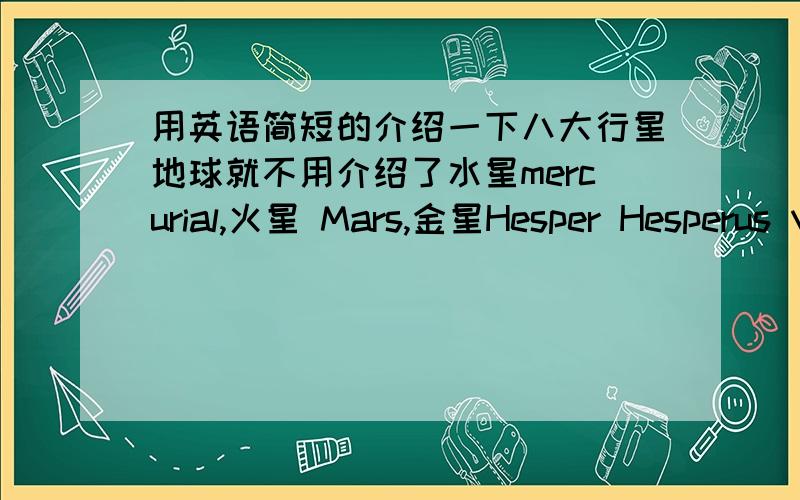用英语简短的介绍一下八大行星地球就不用介绍了水星mercurial,火星 Mars,金星Hesper Hesperus Venus phosphorus,土星 Saturn 木星 Jupiter 天王星,Uranus 海王星,Neptune Neptunian 冥王星 Pluto 每个星球只要简短的
来源:学生作业帮助网 编辑:作业帮 时间:2024/11/16 23:43:15

用英语简短的介绍一下八大行星地球就不用介绍了水星mercurial,火星 Mars,金星Hesper Hesperus Venus phosphorus,土星 Saturn 木星 Jupiter 天王星,Uranus 海王星,Neptune Neptunian 冥王星 Pluto 每个星球只要简短的
用英语简短的介绍一下八大行星
地球就不用介绍了
水星mercurial,
火星 Mars,
金星Hesper
Hesperus
Venus
phosphorus,
土星 Saturn
木星 Jupiter
天王星,Uranus
海王星,Neptune
Neptunian
冥王星 Pluto
每个星球只要简短的介绍一句话就行了
10句话就差不多了,
关于某个星球你知道什么就写什么,一句话就行,但不能太离谱啊!
用英语简短的介绍一下八大行星地球就不用介绍了水星mercurial,火星 Mars,金星Hesper Hesperus Venus phosphorus,土星 Saturn 木星 Jupiter 天王星,Uranus 海王星,Neptune Neptunian 冥王星 Pluto 每个星球只要简短的
Mercury (水星):
——The Mercury is the smallest of the planets and the one nearest the sun,having a sidereal period of revolution about the sun of 88 days (水星是行星中最小且离太阳最近的星,围绕太阳公转所需的周期为88天.)
Mars (火星):
——The Mars is the fourth planet from the sun,having a sidereal period of revolution about the sun of 687 days.(火星是距太阳距离居第四位的行星,绕太阳公转周期为687天,).
Venus (金星):
——The Hesper is the planet Venus in its appearance.The Venus is the second planet from the sun,having a mass 0.815 times that of Earth,and a sidereal period of revolution about the sun of 224.7 days.When appearing as the evening star,it can be called Hesper/Hesperus.(金星是离太阳第二远的行星,它的质量是地球质量的0.815倍,绕太阳转的公转周期为224.7天.傍晚出现时称作长庚星)
Saturn (土星):
——
It is the sixth planet from the sun and the second largest in the solar system,having a sidereal period of revolution about the sun of 29.5 years and a mass 95 times that of Earth.(土星是距太阳第六远的行星,是太阳系中第二大行星,绕日公转周期29.5年,质量是地球的95倍.)
Jupiter (木星):
——
The Jupiter is the fifth planet from the sun,the largest and most massive in the solar system,having a sidereal period of revolution about the sun of 11.86 years.(木星是靠近太阳的第5颗行星,也是太阳系中最大的行星,绕太阳公转的恒星期为11.86年.)
Uranus (天王星):
——
The Uranus is the seventh planet from the sun,revolving about it every 84.07 years.(是离太阳第七近的行星,每绕太阳一周为84.07年.)
Neptune (海王星):
——
The Neptune is the eighth planet from the sun,having a sidereal period of revolution around the sun of 164.8 years.(是太阳的第八颗行星.围绕太阳公转的恒星周期为164.8年)
Pluto (冥王星):
——
The Pluto used to be the ninth planet in the solar system,but now it is listed as the Dwarf Planet.(冥王星曾经是太阳系的第九颗行星,但是现在被列为矮行星.)
Mercury
Mercury is the closest planet to the sun. Its cratered
surface can reach upwards of 800 degrees fahrenheit because of its
proximity to the sun and its slow rotation. Only slightl...
全部展开
Mercury
Mercury is the closest planet to the sun. Its cratered
surface can reach upwards of 800 degrees fahrenheit because of its
proximity to the sun and its slow rotation. Only slightly larger than
Earth's moon, it is the smallest planet in the solar system. It has no
moons, no rings, and a very thin atmosphere.
Venus
The second planet from the sun, Venus, is slightly smaller
than Earth. Because of its relative proximity to Earth, it is the
largest planet seen in the night sky. The cratered surface of the planet
is hot, with surface temperatures around 900 degrees fahrenheit. Venus
has a thick atmosphere of sulfuric acid and carbon dioxide. The density
of its atmosphere makes the air pressure 90 times that of Earth's. This
makes the planet decidedly inhospitable to life.
Mars
Mars, also called the Red Planet, is the solar system's
fourth planet. Its surface is characterized by dust storms, large
volcanoes and deep valleys. The red color of the surface comes from iron
oxide or rust in the soil. Some of the surface features of Mars, such
as dry river beds, hint toward water previously existing on the planet.
The atmosphere is very thin on Mars, with only 1/100th the air pressure
of Earth, and the planet is relatively cold with surface temperatures
ranging from -171 to 32 degrees fahrenheit.
Jupiter
Further from the sun, past a ring of asteroids, lies the
largest planet in our solar system -- Jupiter -- the first of the gas
giant planets. Its characteristic colored cloud patterns are caused by
enormous, swirling storms in its atmosphere. The largest and most
distinctive of these, the Great Red Spot, is large enough to swallow
Earth. The interior of this great planet is mostly hydrogen and helium.
Jupiter has 63 moons and a faint ring system.
Saturn
Saturn, the sixth planet from the sun and the second gas
giant, is unique in that an extensive and complex set of rings orbit the
planet in a thin band. Saturn is large -- about 9.5 times the radius of
Earth. It has 62 moons in its orbit. The interior of Saturn, like
Jupiter, is made of mostly hydrogen and helium in liquid form because of
the strong pressure there.
Uranus
While most planets spin on their axis with a slight tilt,
the gas giant Uranus spins on a plane with the orbit of the sun. This
creates unique seasonal changes. This cold planet is four times the
diameter of Earth, and is made of a large atmosphere of methane with a
dense core of frozen methane. Uranus has a faint ring system and 27
moons in its orbit.
Neptune
The blue planet Neptune is the farthest from the sun and,
like Uranus, is a very cold place. Because of its distance from the sun,
one year on Neptune is 165 Earth years. The large amount of methane in
the atmosphere gives the planet its blue color, and the cold interior of
the planet is mainly methane ice. It is a relatively large planet. Also
like Uranus, it has a diameter roughly four times that of Earth.
Thirteen moons and a faint ring system orbit the planet.
需要说明的是,8大行星里没有冥王星,因为在2006年8月24日召开的国际天文学联合会第26届大会,经两千余天文学家表决通过———太阳系只有八大行星。不再将传统九大行星之一的冥王星视为行星,而将其列入“矮行星”
收起